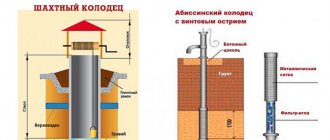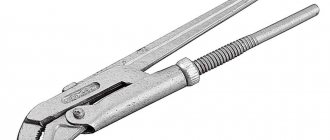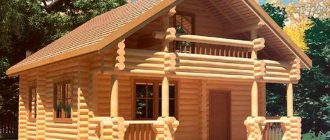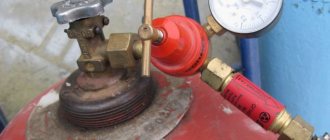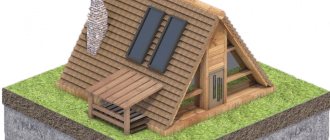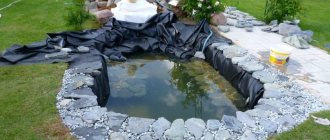Home » Building a house
We are building a house
Vladimir 03/28/2020
6143 Views
SavingSavedRemoved 0
Most holiday villages, especially in the outback, far from large cities, are still not supplied with gas. Therefore, a gas cylinder at the dacha is a necessary thing. Especially where there are power outages. In this article we will try to figure out how to choose and correctly connect a gas cylinder. And also in what cases it makes sense to use it, and in what cases it is better to look for a cheaper alternative to gas.
Acquisition
The first question that arises is which cylinder is best to use.
Some people still use old Soviet-style steel tanks. Either because they were inherited from my grandmother, or because you can buy such a cylinder for pennies or even exchange it with your neighbor Uncle Vasya. But you shouldn’t keep such a monster in the house.
And not only for aesthetic reasons. Any metal, as you know, is susceptible to corrosion, and if the cylinder is already thirty or forty years old, you understand, no one can vouch for its reliability.
Such rarities belong in a landfill or in a museum, and not in a house where people live
In some states of the former USSR, for example, in Latvia, their use is generally prohibited or allowed after mandatory testing and certification. Therefore, we advise you to stop using such cylinders and replace them with modern, safer analogues.
Preparing for installation
Before installing the gas panel, remove it from the packaging and check for mechanical damage. If everything is in order, you can proceed with the installation. But first, check the necessary documentation. To install a gas stove in your home, you need the following documents:
- passport of the owner of the house or apartment;
- certificate of registered residents;
- state certificate registration;
- certificate of registration of a residential property, certificate of ownership;
- subscriber's book (if available);
- receipts;
- meter passport;
- gas equipment maintenance contract;
- registration certificate for the premises.
Diagram of gas pipes in an apartment building
The set of documents must be submitted to the city gas service, which will prepare and issue a new subscriber book, a contract for the provision of gas to a house or apartment. All items in the form must be filled out, after which instructions on the operation of gas appliances are provided. At the end of these procedures, an agreement is concluded with the gas service, which gives permission to install the device. Then you can proceed directly to the installation procedure.
Necessary tool
To independently dismantle the old and install a new slab, you do not need any special tools. Here is a list of what you will need:
- adjustable wrenches;
- screwdriver;
- sealant;
- gas hose;
- gas winding.
To ensure the tightness of the hose connected to the pipe, it is important to choose a high-quality seal. Loctite or Fum Tape are best suited.
Removing old tiles
Before installing a new stove, you must disconnect and dismantle the old one.
First, it is important to turn off the tap. Its complete closure can be checked by turning on the burner. It is better to replace the old petal-shaped faucet with a ball-shaped one - it is more reliable in everyday use
It is better to replace the old petal-shaped faucet with a ball-shaped one - it is more reliable in everyday use.
To ensure that the handle of the new faucet does not interfere with screwing, it should be removed. Next, you should prepare a sealant and a damp cloth. The latter will be useful for closing the hole after removing the old tap. Before work, be sure to open a window or window.
Gas stove diagram
When the preparation is completed, you need to unscrew the old tap and close the pipe with a damp cloth. Then you should clean the thread after removing the tap and apply a sealant. Next, you should act quickly but carefully. You need to get a rag (don’t be afraid of gas escaping, that’s what the window is opened for) and screw a new tap onto the thread with the seal.
It is definitely worth checking the quality of the connection and seal. This can be done using soap foam. Apply it to the joint; if soap bubbles appear, unscrew the tap and check the density of the sealant. If there are no bubbles, the job is done well. If you do not plan to connect the stove in the near future, you need to install a limiter on the tap.
Stove location and installation
Before installing the stove, you should screw the adjusting feet to it and then place it in the place where it will stand. You must act according to the instructions for installing the gas stove and leave the required distance from the wall.
Layout of a gas stove and other devices in the kitchen
The stove must be installed strictly horizontally and stand firmly on all four legs. This can be achieved using a building level and tightening the adjustable legs. You can also use special gaskets.
How to choose a hose
When installing it yourself, you can choose a rubber hose to connect the gas stove. This hose is flexible and is the most convenient for everyday use: it is possible to freely move the stove, if necessary, over a distance of up to five meters.
Thanks to the flexibility of the material, you don’t have to worry about accidental movement of the slab, since the hose will act as a shock absorber that will prevent severe damage that could lead to gas leakage.
The hose for use with a gas stove is available with a yellow mark up to five meters. This length is quite enough. You should not use products from unknown companies. It’s better to spend money once on a certified product that is guaranteed to last for more than one year.
It is also worth paying attention to the outlet of the hose to the stove and the thread, since they vary
Bellows hose
If you follow the regulatory documents, then according to the rules the hose must be bellows. This means that it must stretch in length and also have a protective coating.
Modern steel cylinders
Nowadays welded steel gas cylinders of modern design with a volume of 5 to 50 liters are also produced. However, they have almost the same disadvantages as their older brothers.
The disadvantages include the following:
- Susceptibility to corrosion
- Sensitivity to temperature changes
- Potential Explosion Hazard
Fifty-liter large-volume steel cylinders cannot be placed in the house. They must be installed in special cabinets outside in a place protected from direct sunlight. It is allowed to install small volume tanks indoors.
In any case, they cannot be installed closer than 1.5 m from the stove.
Large-volume steel cylinders may only be placed outside the premises in special cabinets
However, they are in demand due to their availability and relatively low price.
If this is your choice, be sure to follow these guidelines:
- Place the cylinder in a room with a stable temperature, away from heat sources and direct sunlight
- Place large-volume cylinders outside the room
- Regularly check the cylinder itself and the gas line for leaks
Change the neck gasket regularly. It costs little, but it can cause gas leakage, which not only leads to increased consumption, but is also unsafe.
GEFEST 700-02: the best option for a young family
We continue the review, and the next model that I would like to consider is GEFEST 700-02. The device is a compact tabletop stove, which consists of a hob. The device is made in brown color. The dimensions are as follows: height – 11 cm, depth – 37.4 cm, and width – 50 cm. The stove control is mechanical, rotary switches. There are two burners of the same size, 1.7 kW each, and in the “small flame” mode they have 0.4 kW of power.
The hob is covered with enamel: the material reliably protects against corrosion, but you need to clean it carefully, as all abrasions are immediately visible. The rack for the dishes is cast iron and straight, so it may seem that the dishes can slide off it, but this is not the case. The stove is designed to operate from bottled gas, but it can also be switched to operation from regular main gas. There are legs that can be adjusted in height.
GEFEST 700-02 1
GEFEST 700-02 2
GEFEST 700-02 3
So, the positive aspects of GEFEST 700-02 include:
- easy controls;
- excellent assembly;
- low price;
- nice design.
The only drawback: the kit does not include a reducer, you will have to buy it separately, but this is only if you plan to connect the stove to a gas cylinder.
More details in the video below:
Composite gas cylinders: expensive, but reliable
You can purchase more reliable composite tanks for blue fuel. Their main advantage is that they are considered non-explosive and can be placed indoors. The composite cylinder is made from materials based on fiberglass and epoxy resin and is placed in a protective casing that can be easily replaced if necessary.
Their advantages include the following:
- Light weight, almost half that of its steel counterpart
- High safety - they do not explode even at a temperature of +100 degrees
- A bypass valve that releases excess gas if the pressure inside begins to rise
- Transparency of the walls, allowing you to control fuel consumption
Modern composite cylinders can be safely used directly in the kitchen
The main and, in fact, their only serious drawback is their high price.
There are also metal-composite cylinders whose safety indicators are average between the previous two types. But they are of little use for dacha needs and are generally not used in everyday life. Therefore, we will not talk about them.
A variety of gas fireplaces for cottages and country houses
Depending on the installation location, gas heating units are:
- corner - mounted in the corner of the room;
- built-in - located in a wall niche;
- wall-mounted – mounted on the wall;
- frontal - located in the center of the room.
Regarding transportation, gas fireplaces for a summer house or other type of housing are divided into:
- stationary models;
- portable units.
Based on power, they are divided into high-, low- and medium-power.
Depending on the type of fuel used, a gas fireplace for a summer house or home can be functional:
- on natural gas;
- on propane-butane.
Based on the appearance of the firebox openings, devices are divided into:
- fireplaces with an open firebox, in this case it is possible to observe the flame, the efficiency of such a unit is no more than 16%;
- fireplaces with a closed firebox - they have a glass door that can sometimes be opened when it is closed. The efficiency reaches 70-80%.
Regarding the method of emitted heat, there are fireplaces:
- devices with one-way radiation - are the most common option, characterized by an increased degree of heat transfer;
- double-sided gas units are not so popular, but they have a presentable appearance and require large volumes of fresh air;
- gas devices with three-way radiation have a beautiful appearance, but they have poor heat transfer, so they are used for decorative purposes.
Gas-fired heating appliances, depending on their functionality and shape, are divided into the following groups:
- gas stove fireplace;
- boiler fireplace;
- convector fireplace;
- infrared fireplace.
The fireplace boiler provides heating; it is equipped with a portal, so it looks like a fireplace. This unit is able to regulate the degree of heating of the room.
A convector fireplace is a heater that has a front door made of heat-resistant glass; it has a number of advantages:
- presentable appearance;
- fire safety;
- silent operation;
- quick heating of the room;
- a small amount of combustion products.
An infrared gas fireplace without a chimney is one of the popular heating devices. It operates on the basis of butane-propane. The device is used to supply heat to residential premises, industrial or outdoor facilities.
The room is heated by infrared waves, as well as by direct heating of the ceramic panel. Installation of the device does not require significant expenses; it quickly fills the room with comfortable warmth and makes staying in it cozy. An infrared gas fireplace without a chimney does not need to be cleaned of ash.
- When choosing a heating device, you should give preference to the standard model.
- It is better to purchase a gas fireplace without a chimney for your dacha, which combines the function of a stove, which will allow you to warm up the building faster.
- The design of the unit must match the interior of the room.
- The classic style involves installing a rectangular fireplace in the room.
- For a modern environment, it is advisable to choose a unit of a non-standard color scheme and unusual shape.
- Devices with two- or three-sided radiation cannot heat rooms; they serve as a decorative element.
- Infrared outdoor gas fireplaces are chosen for heating outdoor terraces and verandas.
- When purchasing a device, you need to make sure that it has built-in electrical appliances and a temperature controller.
- The heat output required for the room and the power of the fireplace must match.
- You should purchase the device in stores where specialists will help you make the right choice.
- When purchasing a gas fireplace and other equipment for installation, you need to require certificates confirming the product’s compliance with all standards, and in addition, a manufacturer’s warranty.
- In the absence of a centralized gas supply, gas fireplaces for a country house operating from a cylinder are used.
- The cost of a gas unit depends on its type, the popularity of the company that produced it, power, the material used to make the burner, and the design of the portal.
Installation rules and safety precautions
The gas mixture is heavier than air. Gas, in case of leakage, always accumulates at the bottom. However, its odor may not be felt until it reaches an explosive concentration. Therefore, it is strictly forbidden to place gas cylinders in the underground, basements, cellars, pits in the yard or near the house.
This applies to all types of gas containers. If composite cylinders themselves do not explode, this does not mean that they cannot pass gas, which, having accumulated in significant quantities in the same basement, will not explode from an accidental spark. If installed outdoors, metal cabinets with holes at the bottom for ventilation are used.
The cylinder is installed strictly vertically. Horizontal positioning is unacceptable.
The gas pipeline is installed from steel pipes with a wall thickness of at least 2 millimeters. The pipes passing inside the walls are placed in a shell of soft material and foamed with polyurethane foam. Connecting gas stoves and other appliances can be done with hoses specially designed for this purpose.
The reducer is connected to the gas pipeline with a rubber-fabric sleeve (durite hose).
If you are not sure that you can handle this yourself, it is better to contact a specialist.
It is better to entrust the installation of a gas supply system to specialists
Connecting equipment
In order to correctly install and connect the gas cylinder, you need to comply with SNiP standards 42−01, 31−02. If the height of the room is 2.2 meters or more, its volume should be as follows:
- 8 cubic meters for 1 or 2 burner stoves.
- 12 cubic meters for a three-burner device.
- A product with 4 burners will require from 15 cubes.
With ceiling heights of less than 2 meters, these figures increase by 2 times.
As a rule, all the necessary conditions and requirements for safe installation are in the documentation for the stove. In its absence, you need to consult with specialists.
It is imperative that ventilation is provided in the room where gas equipment is installed to prevent the creation of an explosive situation. During installation, this condition must be observed. It is also prohibited to use any power tools to avoid ignition in the event of a possible leak. All work is carried out with the gas supply shut off.
The order is as follows:
- First you need to install the tap in the middle of the gas hose.
- Connect the union nut to the plate, making sure that the gasket is in place. Carefully, without over-tightening, secure it with a key.
- Pull a hose onto the output tube of the gearbox, usually made in the form of a brush, and secure it with a clamp. You need to tighten it tightly, but carefully so as not to damage the tube.
- Align the gearbox horizontally and secure it to the cylinder.
- All threaded connections must be washed and the supply must be opened little by little. If there are bubbles, the connection needs to be tightened. If they don't disappear, then it's all about the gasket.
After checking the tightness, the stove can be used.
Features of use in the cold season
This situation often arises. Gas tanks are located outside in metal cabinets. In the summer everything was fine, but when the temperature drops, a problem arises - gas does not flow into the house.
The reason here is this:
Household cylinders are filled with a butane-propane mixture. The boiling point of butane is about 0°C. The boiling point of propane is 40°C. As a result, at low temperatures, gas burns unevenly and interruptions occur.
There is only one way out - to maintain the temperature necessary for the evaporation of butane. Of course, this does not apply to containers that are located in a room where the temperature is above zero. But those located outside have to be purposefully heated.
One option could be to blow warm air from the room: with a fan through an air duct inserted into a gas cabinet. You can also heat cylinders using the principle of underfloor heating by placing a heating element in the floor of the cabinet. However, the main thing is not to overdo it and not to overheat!
Of course, for heating you cannot use open heating elements like nichrome spirals and, especially, open fire.
Insulate the gas cabinet with mineral wool. This will protect the cylinders from overheating in summer and hypothermia in winter. In addition, mineral wool is a fireproof material.
There are also nuances to refilling cylinders in the cold season, but we will talk about this separately.
The best premium built-in gas hobs
If you have enough money, you can pay attention to advanced technology. Premium-level devices are distinguished by extensive capabilities and durability.
They are chosen not for 4-5, or even 10 years. Typically, manufacturers make the design of top-end solutions suitable for operation for a much longer period.
Hotpoint-Ariston DD 642 (BK)
Independent surface with 4 compact grates for each burner, as well as an express burner. To the left and right of the heating zones there are regulators that have the function of automatically igniting the flame.
The surface of the DD 642 is covered with durable tempered glass, which hardly collects fingerprints and is very easy to clean. At the same time, you can use any detergents and even scrapers with it without fear of leaving scratches.
Advantages:
- many beautiful colors (especially Champagne);
- convenient rotary switches;
- automatic fire ignition function;
- gas control option for burners;
- premium Italian assembly.
Flaws:
The quality of the grilles is 4 minus.
Siemens EC6A6PB90R
What German manufacturers never have problems with is design and build quality. This statement was once again proven by the Siemens EC6A6PB90R gas panel. There are four burners, one large, two medium and one smaller, and rotary switches allow you to smoothly adjust the flame on each of them within 9 modes.
The grate here is cast iron, consisting of two parts, so you can easily clean up spilled soup or fallen porridge on one side of the surface while you are preparing dishes on the other. According to reviews, the gas panel from Siemens is 100% consistent with the recommended cost of 25,000 rubles. The gas here is ignited automatically, and when the flame dies out it is instantly shut off.
Advantages:
- high-quality gas control function;
- automatic electric ignition;
- enamel surface;
- the presence of an express burner;
- elaborate design;
- reliable cast iron grates.
Bosch PCP6A6M90
The popular PCP6A6M90R panel from Bosch visually and in characteristics almost completely matches the Siemens solution discussed above. Even the dimensions here are the same down to the millimeter. But this option can be found cheaper, and its other advantages include a panel lock button, which is not very common in gas models. A slightly modified grille with additional ribs is also noted by users as one of the advantages of the PCP6A6M90 gas hob.
Advantages:
- Flame Select function;
- quick shutdown of gas supply;
- automatic flame ignition;
- great functionality;
- ease of care;
- possibility of blocking control;
- great appearance and affordable price.
Electrolux EGV 96343 YK
A quality solution from a Swedish brand. Model EGV 96343 YK is distinguished by its beautiful appearance and impeccable assembly. The device has four regulators located on the right, each of which includes not only gas, but also automatic electric ignition. The pair of panel grates are made of durable cast iron and are easy to clean.
An important advantage of the Electrolux EGV 96343 YK is the WOK burner, which has several dividers. Due to this, the dishes heat up not only more evenly, but also much faster than in standard heating zones
It is important that all the burners are spaced apart from each other at such a distance that several large-diameter pots or pans can be installed on the panel
Advantages:
- thick impact-resistant glass;
- convenient placement of burners;
- thoughtful arrangement of controls;
- cast iron grates with soft linings;
- powerful Triple Crown burner;
- well thought out control panel.
Flaws:
the price is a little high.
Gas for heating: pros and cons
Gas boiler connected to cylinders
Gas boilers are now used everywhere because they are simpler and more convenient than solid fuel ones, and cheaper to operate than electric ones. But this is where there is a centralized gas supply. But what about in our case?
The main questions that arise for any summer resident who is thinking about a liquefied gas heating system:
- Is it possible to effectively heat a house by powering the boiler from a cylinder?
- How long can a boiler operate on one cylinder?
Let's figure it out.
So how much gas is in the cylinder?
- Cylinder capacity 50 liters. The cylinder contains 21.5 kg of gas*.
- 27 liters – 11.4 kg*.
- 12 liters – 5.3 kg*.
- 5 liters – 2.3 kg*.
*Data taken from the markings on the cylinders. In reality, the numbers may differ.
How many cylinders are required for continuous stable operation of a gas boiler?
- The average gas consumption for the boiler is 15 liters per day per 100 sq.m. heated area.
- One 50 liter tank holds about 22 kilograms of gas, which corresponds to approximately 35-42 liters.
- That is, one such tank is enough for two days.
Constantly using liquefied gas for heating only makes sense if you have a gas station nearby or have several filled containers in stock.
For long-term uninterrupted operation of the heating boiler, you will need a whole battery of gas cylinders
In addition, in any case, the cylinders will have to be transported to a gas station, which means additional costs for gasoline plus wasted time.
Therefore, heating with liquefied gas may make sense in the following cases:
- The heated area of the house is small and the house is well insulated, which will reduce gas consumption to a minimum
- In the near future, your holiday village is planned to be gasified, so the use of liquefied gas is a temporary measure
- Gas heating is used for a small amount of time and works in conjunction with other heating equipment
- You have access to very cheap, or better yet, free gas, which, of course, is extremely unlikely
By and large, using bottled gas for heating only makes sense occasionally: you’ve arrived at the dacha, the house is cold, you don’t have time to chop wood or you’re just too lazy, and the room needs to be warmed up. But in this case, installing a gas boiler is impractical.
If visits to the dacha are infrequent during the cold season, you can purchase and install gas heaters in the room. You can warm up in just a couple of minutes. At the same time, you will save on installation of the heating system and fuel.
If your trips to the countryside are irregular, and, in addition, you have an unheated garage, buy a portable (mobile) gas heater. It can be easily moved around the house, transported by car, installed in any room and quickly raise the air temperature in it to a comfortable one. The gas cylinder is placed inside such a heater and covered with a protective casing.
What do you pay attention to when buying a gas heater?
One of the key characteristics of this device is its power. Due to this, it is possible to find out what area the equipment will be designed for. According to experts, 1 kW of power is enough to efficiently heat about 10-12 square meters of a room; accordingly, a 4 kW device is suitable for a room of about 40 meters. However, it must be remembered that the packaging or instructions indicate the maximum power of the device, which will be used when the required air temperature in the room is reached. The rest of the time the device will work weaker - 1.6 kW, 3.2 kW and so on.
If the heater needs to be moved to another room, it will have to be optimized for its area. The fuel used is propane or butane. Here it is already necessary to take into account what time of year it is planned to use this equipment - winter, spring and autumn. Propane performs excellently in very cold or low positive temperatures. Butane functions more efficiently in the off-season, on cool nights, and so on. Such heaters are often installed even outdoors - on the veranda, in summer cafes, and so on. On sale you can even find universal designs that can use both types of fuel.
To make using the heater as convenient as possible, it is equipped with various additional equipment - piezo ignition, gas control, and so on. Many elements are installed in order to prevent spontaneous combustion during operation - usually a special system of additional valves acts in this capacity. Such automated operation allows the equipment to function completely autonomously, that is, without human intervention. It is very convenient if it is possible to connect such a heater to a gas pipe or cylinder - this makes it even more versatile.
All such heaters can be divided into three large groups - convector, infrared and catalytic. Infrared products are the most effective for heating small spaces, and they do it quite quickly. The operating principle of such devices is such that they are excellent for outdoor use, since it is not the air that is heated, but the objects in the immediate vicinity.
Catalytic devices are the most expensive, since platinum and fiberglass are used in the production of fuel oxidizer. Such a device allows you to effectively heat the air in a room whose area does not exceed 20 square meters. Convector devices are the cheapest and simplest in design. They are used both in country houses and outdoors. Additionally, they are equipped with a fan that sends heated air further into the room. The safety of their operation is controlled by special sensors and systems that do not allow the housing to heat up to temperatures exceeding 60 degrees.
When compiling our rating of the best gas heaters, we took into account both all these points and the price-quality ratio of the device. The most expensive designs were not included in the review. For each of the models, we tried to collect as much useful information as possible to make it easier for you to choose this equipment. So, it’s time to start directly reviewing specific gas heaters.
Gas for a generator: cheaper than gasoline, but still expensive
The same applies to the use of gas for electricity supply. Of course, a gas generator is cheaper to operate than a gasoline generator, but it still consumes a lot of fuel. When you connect a generator to a gas pipeline, that’s one thing, but when you use it with a cylinder, the gas again won’t last long.
Those who have used gas generators say that at a load of up to a kilowatt, the generator consumes 1.2-1.5 kg of gas per hour. That is, a 50 liter tank is most likely not enough for a day of continuous operation.
If you have a gas generator, you won’t be able to get by with just one cylinder either.
Therefore, this option can be considered as a forced short-term measure - the light has gone out, and you urgently need to charge the battery, turn on the refrigerator, etc. Constantly using a gas generator using liquefied gas is expensive, as is the case with heating devices. However, if you already have a need to purchase a generator (frequent power outages in your village), then it makes sense to get a gas one instead of a gasoline or diesel one.
Types and their technical characteristics
There are several criteria by which tabletop stoves are divided. First of all, this is the number of burners, which determines the scope of application.
- A portable single-burner stove is often used on trips, hikes, and fishing. It can serve one or two people. The device is small in size and light in weight, powered by collet cylinders. Represented by models of the Pathfinder brand.
- A portable two-burner stove can serve several people. It is also represented by various models of the Pathfinder brand. A special feature of these devices is the ability to connect each burner to its own cylinder.
- A portable three-burner or four-burner model will delight the owner with wider functional capabilities. This device can be fully used both at home and in the country.
Also, tabletop stoves can have burners of different sizes, types, and even shapes. The choice of burner size is influenced by the dimensions of the cookware used.
In terms of shape, the most common are circular flame burners. Some modern stoves have special burners with two or three circuits. This means that the same burner can have two diameters (large and small), which allows you to save gas and determine the most suitable cooking mode.
There are also models with a ceramic burner, oval-shaped burners (very convenient for dishes of the appropriate shape), and triangular ones, on which you can cook without a grate. As for the grate on stoves, it is most often made of cast iron or stainless steel.
Depending on the type of gas used, tabletop stoves are:
- for natural gas, which are connected to a stationary gas pipeline in a small apartment;
- for liquefied gas cylinders for summer cottages;
- combined, the design of which provides for connection to both the main gas and the cylinder.
An example of a stove designed for main gas is the mini-model Flama ANG1402-W. This is a 4 burner stove with one of the higher power burners providing fast heat and the rest being standard. Rotary knobs adjust the strength of the fire.
The tile is covered with white enamel. The metal grilles are also enameled. The model is complemented by a lid, low legs with rubber attachments, and shelves for dishes.
Model Delta-220 4A is a desktop stationary mini-stove. It runs on bottled gas. The hob is equipped with 4 burners of varying power. The body and hob have a white enamel coating. A special protective cover protects the wall from contamination by splashes of grease and liquids.
A special type of tabletop stove is a combination tabletop stove with an oven (gas or electric). This model is in no way inferior to a conventional stationary stove and greatly expands the possibilities of cooking. Such stoves have doors made of double-layer heat-resistant glass, a temperature indicator, and are often equipped with a grill.
The compact 4-burner stove with oven Hansa FCGW 54001010 has small dimensions (0.75x0.5x0.6 m), allowing it to be installed in a small area. The illuminated oven has a capacity of approximately 58 liters. It is equipped with a thermostat that helps you check the temperature inside. The oven door is made of two-layer heat-resistant, low-heat glass, eliminating the possibility of getting burned.
The burners have different sizes: large - 9 cm, small - 4 cm, and also two 6.5 cm. Their total power is 6.9 kW. Electric ignition is carried out through rotary knobs. There is a gas control option that turns off the gas supply if the fire goes out.
Gas stove in the country - the best choice
A gas stove is probably the most common cooking device.
Of course, you can use electric stoves. But, if the electricity at the dacha is suddenly turned off, you cannot do without a gas stove. Well, why not cook food over a fire in the 21st century? This is, of course, romantic, but not always practical.
Gas stoves using liquefied gas have been used in dacha cooperatives for a long time. They do not consume much fuel, so one refueling may well be enough for the summer season. You can find out how much gas your gas stove consumes by studying the technical documentation attached to it.
For example:
- Your four-burner stove model has a maximum gas consumption of 486 g/h.
- That is, if all four burners are burning at full power, then a 50 liter cylinder will be enough for 44 hours of continuous use.
- Of course, if fewer burners are turned on, then gas consumption will decrease.
When choosing a slab, there are no special requirements for it for use in dacha conditions. Choose a stove according to your preferences. If you do not plan to live in the country permanently and will cook infrequently and a small number of dishes, choosing a portable tabletop model with two burners would be ideal. It is easy to connect, small in size, and can be easily moved to any other place or transported in a car.
Portable gas stove - the optimal solution for a summer house
If you live outside the city all the time, for example in the summer, then it makes sense to purchase a full-fledged stationary stove, which also includes an oven. But keep in mind that using an oven will significantly increase gas consumption.
When purchasing a stove, you need to check with the seller about the need to purchase a special reducer designed to reduce the pressure of the gas leaving the cylinder.
In a regular gas pipeline supplied to a home stove, water heater or boiler, the pressure of natural gas is about 0.05 atmospheres, and in a high-pressure gas cylinder up to 200 atmospheres. By default, a reducer must be installed if you buy a regular gas stove, and not one specifically designed for use with a gas cylinder.
Popular models
On sale you can find many stoves for bottled gas. Among them there are devices that are purchased especially often:
- The small gas stove Summer Resident has 4 burners, one of which is of high power. Weight is 20 kg, there is no oven, but there is an attractive price (about 4 thousand rubles).
- A compact stove that operates both from a cylinder and from network gas Lada-Lux has 4 burners and a 54-liter oven. Requires installation of a large cylinder.
- The inexpensive Nord stove is equipped with an oven, gas control and a separate grill. Some models have glass lids and electric ignition.
- For small spaces, you can purchase products under the Ricci brand. The model range is wide, with a different number of burners and coatings from enamel to glass ceramics.
- The two-burner Mechta 200 M stove is designed to operate from any gas source. Available in black or white. Easy to care for. There is a glass-enamel coating, an economical low-flame function, and rubberized legs.
- From the model line from the Hephaestus company, you can choose the most compact stove, Tourist PGT-1, with one burner and a weight of 1 kilogram. There is also a full-fledged version of Gefest PG 100, which in appearance resembles a large microwave oven. Its arsenal includes an oven with a tempered glass window, operation on both liquefied and main gas, a baking rack and a roasting pan.
- The line of 50 models of Darin’s company is based on equipment from the French company Brandt. The 1 AS GM521 001 stove has a classic design with an enamel hob, gas control, bar grate and nozzles for switching to different gas supply systems. Two-burner modifications are available.
- Models for bottled gas from the Slovenian manufacturer Gorenje are quite expensive, but functional and ergonomic. Almost all stoves have gas control and electric ignition, as well as an oven with a cool door.
- An inexpensive two-burner Greta stove would be a good option for a summer cottage. Models available for both types of gas.
- The equipment called ELNA PG-2-N has 3 burners, closed with a lid. The weight of the plate is only 4 kilograms. Despite the budget category, there is an electric ignition system. Runs only on liquefied gas.
- The Saturn brand represents inexpensive equipment for the garden. There are models with different numbers of burners. True, according to customer reviews, a single-burner stove is not economical.
- For fans of individual hobs, there is an expensive example of Zigmund Shtain GN 58.451. It is distinguished by a stylish design, gas control, and multi-circuit flame. Available in black or white models. Number of burners: 3.
The choice of gas equipment for a summer residence must be approached seriously, since the operation of such equipment is associated with increased danger. It is better to purchase products with well-known names from trusted sellers.
Gas burner - budget option
For infrequent use in the country, gas burners are excellent. This is an option for those who do not have the desire or means to buy a gas stove with a cylinder. The advantages of a gas burner are as follows:
- Low price compared to a full gas stove
- There is no need to buy a cylinder separately - it is already included in the kit
- No connecting hoses or gearboxes needed
- Light weight, compact size and high mobility
Gas burner - an economical option for a summer residence
But you need to be aware that a gas burner is more of a tourist option. At the dacha, this is more of a situational replacement, for example, for an electric stove in case of a power outage
Constantly cooking food on it will be problematic for the following reasons:
- One burner
- The design is not designed for the use of large capacity cookware
- Small fuel volume (3-5 liters)
Therefore, if the house does not have an electric stove, a burner is not the best option. You can boil a kettle or fry eggs, but it’s not enough for full cooking.
Budget (up to 15,000 rubles)
Gas stoves in the budget segment have a standard set of functions and are easy to use. The enamel coating, typical of inexpensive slabs, is aesthetically pleasing, durable and easy to clean.
GEFEST 3200-08
pros
- Good oven insulation
- Reliable adjustment knobs
- High quality enamel
- Spacious lower storage compartment
- Convenient temperature panel
Minuses
- Slippery grate
- No light in the oven
- No gas control for burners
The Belarusian model 3200-08 is suitable for those who are looking for a simple and high-quality gas stove at an affordable price. Compact dimensions allow you to place the product in a small kitchen. The combination of white and black colors in the design gives the model a modern appearance.
The stove is simple and easy to use. High-quality enamel coating washes well. The hob has 4 burners of different sizes: 3 standard and 1 quick heat. The oven is equipped with a baking sheet, a wire rack and a roasting pan.
DARINA 1B GM441 005 W
pros
- Easy to use
- Robust design
- Child lock function
- Convenient grille
Minuses
- Brittle cord (cracks due to temperature changes)
- The oven glass gets very hot during operation.
- Inconvenient ignition of the oven
The gas stove from the Russian B GM441 005 W has good basic functionality and a stylish appearance. The design of the model includes adjustable legs that can be installed at the same height as the kitchen unit.
The beautiful glass table cover, when unfolded, protects the walls well from splashes during cooking. Convenient gas control knobs have a child safety feature.
The practical arrangement of four burners allows you to use pots of different sizes at the same time.
The stable grid is divided into two parts, which is convenient when cleaning the hob. There are jets for liquefied gas 3000 Pa and a utility compartment. The 50-liter volumetric oven is equipped with two baking sheets and a wire rack.
GRETA 1470-00 isp. 16WH
pros
- Small size
- Volumetric oven
- Adjustable feet
Minuses
- Lack of gas control of burners
- The control zone gets very hot when the oven is on
Product of Ukrainian 1470-00 isp. 16 WH is equipped with a minimum set of functions and is suitable for a family of two people. The model is made in white with a stylish accent in the form of a black oven door. The legs are conveniently height adjustable.
The practical enamel coating and plastic panel make it easy to keep clean. The 58-liter oven is equipped with lighting and quickly heats up to the desired temperature. The oven door is equipped with a temperature sensor and is protected from overheating by double glass. At the bottom there is a utility compartment for storing utensils.
De Luxe 506040.03g
pros
- High quality build
- Good burners made in Italy
- Oven gas control
- Compact dimensions
Minuses
- Small oven volume (40 l)
- Not very convenient location of burners
Gas stove 506040.03g of domestic production “De Luxe” of the budget Evolution series. The oven is equipped with high-quality thermal insulation, which allows you to get good baked goods. The built-in mechanical timer will help you keep track of the exact time.
The product is equipped with all the necessary functions:
- electric ignition of burners and ovens
- thermostat
- gas control.
Massive cast iron grates reliably protect the cooking surface and are durable. Four burners provide an even fire, and there is a “small flame” function. The lower compartment, intended for household needs, is equipped with a hinged lid.
GEFEST 3200-06 K62
pros
- Good quality
- Safety
- Appearance
- Functionality
Minuses
- Difficulty adjusting oven temperature
- Inconvenient surface cleaning
- Electric ignition is unstable
The stove from "GEFEST" 3200-06 K62 is of good quality and attractive appearance. The model is made in silver color and has a transparent table cover. The cooking surface is protected by durable cast iron grates. The width of 50 cm allows you to comfortably place the stove in a small kitchen.
The product is equipped with an electric ignition function and an alert timer. The oven is equipped with two baking trays (for baking, frying) and a spit for grilling dishes. A special grill burner gives a golden brown crust to meat or poultry. Additional safety is provided by the gas control function.
Refilling gas cylinders: what not to do
Regardless of which gas equipment from the above you use at your dacha and how many liters of gas you have in stock, sooner or later the blue fuel in your storage will run out. Its reserves need to be renewed from time to time. How and where to do this correctly?
There are several ways:
- Buy a new, already filled cylinder
- Fill the gas cylinder yourself
- Exchange an empty cylinder for a filled one
- Go to a gas station
We will not consider the first two options.
It is irrational to buy a new cylinder every time. This option is only suitable as a last resort, when you urgently need to replenish fuel reserves, but it is not possible to do this quickly, or the cost of traveling to the nearest gas station exceeds the cost of purchasing a new cylinder.
Also on the Internet, in various thematic forums, options for using foreign-made gas stations or homemade methods of filling with compressed gas from the main gas pipeline are actively discussed.
The first option is too expensive for the household needs of a summer resident, and the second is fraught with various bad consequences both during refueling and after it. If everything here was as simple as they say, all gas-powered cars would long ago have been refueled from a gas stove, and gas stations would have gone bankrupt and closed.
Refueling by exchange
Here we immediately encounter a problem. The service for exchanging empty cylinders for filled ones is not available everywhere. If there is an opportunity to use such a service, the consumer himself is not always ready for such conditions. Suppose you recently bought a new cylinder, and at an exchange point they offer you an old one, which has been in use for several years, for exchange.
PROS:
- You receive a refilled cylinder immediately, you do not need to wait until it is refilled
MINUSES:
- Exchange is not available everywhere
- You get someone else's cylinder in exchange for yours
Refilling your own cylinders
Refilling a cylinder using special equipment
The procedure is simple: you leave your cylinder at the gas filling station and after some time you pick it up, already filled.
PROS:
- You still have your cylinder
MINUSES:
- You may have to wait 1-2 days
Please note that household cylinders need to be refilled at special gas filling stations. A gas station where cars with gas equipment are serviced is not suitable for such purposes!
A regular gas station is not the best place to refill household cylinders.
Formally, gas stations do not provide such a service because they do not have the appropriate equipment and license. But in practice this often happens.
Why shouldn't you fill up gas at a gas station?
- At such gas stations, cylinders are not checked for defects and gas leaks.
- The gas used for cars is technical gas, which is not recommended for everyday use.
- At car gas stations, gas is pumped to capacity, which is unacceptable for household cylinders, especially in winter (this will be discussed separately).
Immediately before refueling, the cylinder must be emptied of condensate and gas residues. This is not done at gas stations! Gas filling is carried out strictly on the basis of its characteristics specified in the technical data sheet.
Additional recommendations and conclusions
Before performing installation operations, it is necessary to determine the installation location of equipment and cylinders. To make it easier to replace gas containers, a special cabinet is created for them. It is located outside the building. This option also improves security.
A hose is purchased that is suitable for working with gas equipment. During installation, the condition of the threaded connections is checked. The total volume of gas storage tanks should not exceed 50 liters.
The equipment installation process does not seem difficult. However, it must be done carefully. In accordance with the current rules, even a small two-burner gas stove for a summer house under a cylinder must be installed by a qualified specialist. The services of a professional from a local service company are inexpensive. If you formalize the connection, problems during future operation will be eliminated.
General useful information
Placement
If you plan to store gas at sub-zero temperatures, please note that you should only buy a propane-butane mixture that is marked “winter”, otherwise it will not be used up all. Another advantage of installing a cylinder on the street is that there are no gas leaks in the living space (if this suddenly happens).
By the way, installation in unventilated rooms, as well as below ground level (for example, in a cellar/basement) is not permissible. The fact is that propane is heavier than air, and therefore, in the event of a leak, it will begin to accumulate, and at a ratio of 2.35 to 9.55% to air, propane can even form an explosive mixture. Also, the distance from the kitchen stove to the gas cylinder must be at least 1 meter, and also at least 1 meter from heating appliances.
Installation diagram
To connect the stove to gas in a country house and a permanent building, different schemes are used. So, how to connect a gas cylinder to a stove in a residential building? In this case, it would be rational to have a supply in the form of several cylinders, which will be stored in a separate cabinet. The latter must be installed on a concrete foundation, the height of the base of which will be 25-30 cm above ground level. The distance from the wall of the building to the cabinet should be 50 cm, and from the slab to the pipe passing through the wall at least 20 cm. It is also worth considering that you cannot install a cabinet with cylinders from the side of the facade of the house and the transport passage.
How to supply a summer kitchen with gas
To correctly connect a gas stove to a cylinder at the dacha, use the following diagram:
- The stove should be installed no closer than 75 mm from the wall - this distance is required so that the hose connected to the fitting does not bend.
- The cylinder should be installed at a distance of at least 1 meter, and the hose that will be used for connection must be at least 150 cm in size.
- To securely fix it in a vertical position, you should fasten the hose with a clamp that will be mounted into the wall.
Types of gas tanks
In order to deliver gas to the place of use, several standard tank sizes are used. For frequent use, it will be easier to buy a large cylinder, while for use in the country, you can choose a smaller container. Such a cylinder will be convenient to transport and it will be easier to find a place for it in tight spaces. The cylinders have a number of characteristics:
| Volume (liters) | Weight of container when unfilled (kg) | Full container weight | Amounts of gas in m3 | Acceptable refueling limits (liters) |
| 5 | 4 | 6 | 0.95 | 4.25 |
| 12 | 5.5 | 11 | 2.6 | 10.1 |
| 27 | 14 | 26 | 5.39 | 13 |
| 50 | 22 | 43.2 | 10 | 42.5 |
Please note that the volume of gas (propane) poured will be less than the volume of the container itself. This is due to the safety of the cylinder, since gas filled in the winter will begin to expand in a warm room and can even rupture the cylinder if it contains more gas than required by regulations
Two in one
In order to reduce the number of calls to gas stations and reduce transportation costs for gas delivery, you can connect several cylinders into a single system. Such a connection is called a ramp. How to connect two gas cylinders to a stove? To do this, you need to add several devices to the connection diagram:
- Additional cylinder.
- M4 fitting with nut for connecting a hose.
- Valve splitter M16. It connects 2 gas hoses together, opens and closes the gas supply.
- Propane reducer N080. This device maintains a constant pressure in the system as the pressure in the cylinders decreases.
- Connector SP 21.8. It is needed to connect the hose to the reducer.
- Brass nipple DN9 (3 pcs.). These parts connect the hoses to the splitter.
- Union nut M 16x1.5 (3 pcs.) secures the spools.
In this way, you can connect as many cylinders as you like. Such schemes are also used for heating houses.
Tips for choosing
As a conclusion, here are some recommendations from experts on choosing the optimal model of a tourist gas stove.
Efficiency is the most important indicator on a hike, because you have to carry the fuel supply on yourself in the literal sense of the word. The efficiency of ceramic burners is 30% higher than that of classic burners, with the same gas consumption. However, ceramic burners are susceptible to moisture. If water gets into the honeycomb of a ceramic burner, the device will fail; Compactness
When camping, stoves should not take up much space, so pay attention to compact models with a maximum (for given dimensions) cooking surface area, which will allow you to use large cookware; Weight. The weight of the tiles varies from 0.8 to 5 kg and above
If weight matters, and an autonomous source of fire is necessary on a hike, then pay attention to gas burners, the weight of which is in the range of 100-400 grams.
Watch a video on how to choose a gas burner
Gas stoves for a summer residence - how to choose, design, connect
Which gas stove is better for a summer cottage under a cylinder? Tabletop or floor-standing? It's all about the availability of free space. If you have somewhere to install a floor-standing option, take it. Even if they are more expensive, they themselves can serve as a cabinet. And there are usually not enough of them (cabinets) at the dacha. Just remember that you still need to find a place to store the cylinder. It can be located nearby (the minimum distance between the stove and the cylinder is 0.5 meters and at a distance of at least 1 meter from the heating devices), or it can stand on the street in a special cabinet that is locked with a key.
If, on the contrary, there is space on the table, but not on the floor, a tabletop version of a gas stove will do. The best part is that they cost one and a half to two thousand rubles.
Number and type of burners
A gas stove for a summer cottage under a cylinder can have from one to four burners. A single-burner is suitable if there are only one or two people at the dacha and you don’t do any twisting. To prepare breakfast/dinner for a family of three to four people and a small amount of preserves, two burners are enough. Well, if you need it and dinner for a full family, take it with three or four burners.
Options for tabletop gas stoves for a summer cottage under a cylinder
Recently, in addition to standard, medium-sized burners, they began to make even larger and smaller ones. This is convenient, since dishes come in different diameters. Such “excesses” are available only on four-burner options.
In addition, there are models that have electric burners in addition to gas burners. If there is light in the area, and you need a stove for your cottage with a cylinder for three or four burners, this is also convenient. The gas in the cylinder tends to run out at the most inopportune moment. If you don't have a spare one, at least start a fire. And if you have an electric burner, you can finish the process and hold out until the cylinder is filled.
Availability of additional options
The range of additional functions just for gas burners is small. These are electric or piezo ignition and gas control. Both functions are useful, but how necessary it is is up to you to judge. It’s worth saying right away that they are very rare in desktop versions.
Gas tabletop stove with electric oven underneath
Design features
There are only a few types of tabletop stoves. The simplest is one, more often two burners, and that’s it. But there are also models with a built-in electric oven. Not a bad option if you use an oven. This is where the species “diversity” ended.
Floor-mounted gas stoves for summer cottages have slightly more design options:
- With built-in gas or electric oven below.
- With shelves at the bottom.
- With a small cabinet and doors. Two exactly “dacha” options
The cabinet under the gas stove can be used to install a small gas cylinder in it. This contradicts the requirements of gas workers (the distance between the stove and the cylinder must be at least 0.5 meters), but is still used.
Where can't you place the cylinder? In the basement or ground floor, in a residential area.
Installation of the plate to the cylinder
How does the process of installing a gas stove to a cylinder take place? To do this, you will definitely need a gas reducer with a special output pressure of 30 mbar, as well as a gas hose made of rubber or a mixture of rubber and polymer and a fitting with a thread inside.
Connecting the cylinder through a gas reducer
To connect the cylinder you will need an adjustable wrench
The sequence of actions is as follows:
The fitting must be screwed onto the inlet pipe of the stove (sometimes the fitting is included in the stove kit). This procedure is absolutely safe, and you can implement it yourself without the involvement of specialists.
Connecting the gas hose to the stove nozzle
In this case, we must not forget about using a gasket, fum tape or some kind of specialized sealant, the type of which depends on the fitting used.
For a reliable connection we use sealants
The reducer must be connected to a gas cylinder and the gasket must be reinstalled immediately.
Connecting the reducer to the cylinder
The outlet of the reducer should be combined with a gas hose.
Connecting the hose to the reducer
It is most rational to connect several cylinders to the stove at once. This will allow you to provide yourself with gas reserves for the entire summer season.
Group connection of several cylinders
Why do cylinders explode?
Cylinders most often explode due to violations during operation and improper safety precautions. Do not place cylinders near an open fire or other heat source. If you observe the process of increasing pressure inside your cylinder, then you must take action. From an instant increase in temperature, the liquid immediately ignites and a ball of fire is formed; in an open space, fragments can fly up to a distance of 300 meters.
If you fill your cylinder incorrectly, it can also explode. You shouldn’t fill the balloon “to the brim”; it’s enough if you cover its volume by seventy or eighty percent. Fill your cylinder not based on the maximum volume, but focus on weight.
Because if you, for example, bring your vessel with gas into a warm room (and before that it was standing in the cold in winter), then the gas will instantly begin to rise in temperature. There is a possibility that the cylinder may simply explode, since the gas simply has nowhere to go.
Installation of a cylinder in the house
The previously mentioned standards make it clear that the owner will not be able to install a power source for gas equipment in the basement and on the ground floor.
There are other important requirements:
- the cylinder must always be in a strictly vertical position;
- the device must be in a condition in which it can be inspected or replaced;
- the minimum distance between the vessel and the gas stove is 50 centimeters, the radiator is 1 meter;
- if the cylinder is operated near a combustion furnace, a distance of two meters must be maintained between them.
It is allowed to store closed containers with a volume of no more than ten liters inside a residential premises. If containers made of unbreakable or non-flammable material are used, their maximum volume should not exceed three liters.
But even it is prohibited from being installed in the kitchen, in a residential building, in an apartment room, on emergency routes, on a balcony, loggia and attic.


